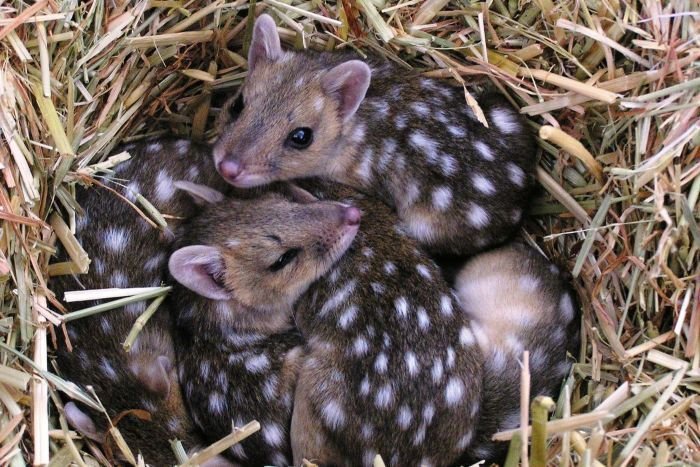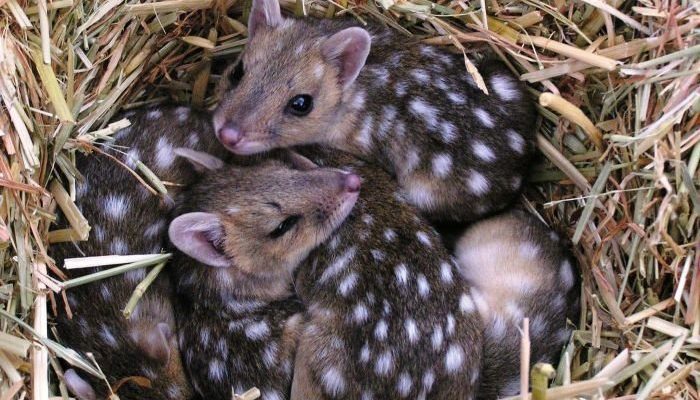
Just like any good parents, quolls have specific routines and strategies to ensure their offspring thrive. They balance their roles between hunting, protecting, and nurturing, all while navigating the challenges of the wild. Let’s break down how these remarkable creatures manage to raise their young in a sometimes harsh environment.
Quolls and Their Unique Reproductive Traits
Quolls are part of a special group called marsupials, which means they give birth to relatively undeveloped young. Right after birth, quoll babies are tiny—about the size of a pea! They have to claw their way from the birth canal to their mother’s pouch, where they latch onto a nipple to grow. This journey is incredibly important as it sets the stage for their development.
The pouch acts like a safe haven—think of it like a cozy aquarium filled with nurturing fluid. Here, the babies can grow and develop without the pressures of the outside world. The mother provides all the nutrients they need until they’re big enough to emerge. This early stage is essential; it gives the young quolls a head start on survival in their often dangerous habitat.
You might wonder how many babies a quoll has at once. Well, it varies! Depending on the species, a mother may have anywhere from two to six youngsters. It’s a bit like a surprise party for the mother, as she has to quickly adapt to caring for several tiny squirming creatures.
Motherly Care: Feeding and Protection
Once the babies leave the pouch, the mother quoll takes on the role of a full-time caregiver. She doesn’t just sit back and relax; she has to find food and keep her little ones safe from predators. This can be quite a feat, especially since quolls are also prey for larger animals like eagles and dingoes.
Feeding the young quolls is crucial. The mother will hunt for insects, small mammals, and even birds to bring back to her den. There’s a bit of a balance here—she needs to hunt for herself while also ensuring her youngsters have enough to eat. Can you imagine being a parent and juggling both work and family time? It’s quite the task!
To protect her young, the mother quoll often chooses den sites that are well-hidden. These dens can be located in hollow logs, rock crevices, or dense vegetation. The idea is to keep the little ones out of sight, which is important for their safety. When danger is near, she may also use distraction techniques to lure predators away from her home.
The Growth Journey: From Pouch to Independence
After around six weeks in the pouch, the babies begin to peek out into the world. This transition is a big deal—they’re starting to explore their surroundings! The mother grants them a bit of freedom while still closely monitoring their activities. It’s like giving a teenager their first taste of independence, but with a watchful eye.
As the babies grow, they start to learn essential survival skills. They watch their mother hunt and begin to mimic her actions. This learning process is vital; it’s how they pick up on the tricks of the trade, like how to stalk prey or recognize safe foods. You can almost picture them practicing their hunting techniques in playful ways, gaining confidence with every attempt.
Eventually, around three months old, the young quolls will start to venture out on their own. While they might still hang around their mother for a bit longer, they’ll gradually become more independent, preparing for a life of their own. This gradual separation is similar to how we teach our kids to be self-sufficient; it’s all about finding that perfect balance of guidance and freedom.
Social Structures and Learning
Quolls are generally solitary creatures, but they do interact with each other, especially when raising young. The social dynamics can be quite interesting. Mother quolls usually raise their young alone, but they may share their territory with other quolls. This can lead to competition, but it also provides young quolls with opportunities to learn from other adults.
Young quolls learn critical social skills from observing the adult behaviors around them. They might pick up cues on how to establish their territories or communicate with others. It’s like attending a workshop where you absorb knowledge—except for quolls, it’s real-life experiences that teach them how to survive in the wild.
Strong social interactions can also help reduce stress for the mother. When she feels secure in her environment, she can focus more on nurturing her young. It’s a classic case of “it takes a village,” even among quolls, as cooperative behaviors can lead to better outcomes for the whole family.
The Challenges of Raising Young in the Wild
Let’s face it; raising kids anywhere is tough, but especially in the wild. Quolls face numerous challenges, from food scarcity to the presence of predators. These challenges can lead to high mortality rates for young quolls. It’s a harsh reality of nature, where survival isn’t guaranteed.
One major issue is habitat loss. As humans continue to expand their territories, quolls often find themselves with fewer safe spaces to raise their young. This loss can make it increasingly difficult for mothers to find appropriate dens or food. It’s a sad situation, as it impacts their ability to thrive.
Disease is another challenge. The wild is teeming with potential health threats. Quolls can fall victim to various parasites and illnesses. When mothers are unwell, it can affect their ability to care for their young, further complicating their survival.
Conservation Efforts to Support Quolls
Given the challenges that quolls face in the wild, conservation efforts play a critical role in supporting these unique marsupials. Organizations dedicated to wildlife preservation work hard to educate the public, protect habitats, and create sustainable environments for quolls.
One effective approach involves setting up wildlife corridors. These corridors allow quolls and other animals to safely navigate through landscapes that humans might otherwise disrupt. By protecting their movement, we’re essentially helping ensure that these creatures can continue to thrive and reproduce without undue stress.
Community involvement is also key. Educating people about quolls and their needs can cultivate a sense of stewardship toward these animals. When communities rally around conservation efforts, it can lead to transformative changes and better outcomes for quolls and their young.
The Role of Quolls in Ecosystems
Finally, let’s take a moment to recognize the role quolls play in their ecosystems. As predators, quolls help control populations of small mammals and insects. This balance is crucial for maintaining healthy ecosystems. When quolls thrive, they contribute to the overall health of their environment, which benefits many other species, too.
By raising their young successfully, quolls ensure that future generations can continue this important work in the ecosystem. It’s like a chain reaction; healthy quoll populations can lead to vibrant habitats and a more balanced environment.
In conclusion, quolls have fascinating ways of raising their young in the wild. From the moment they’re born, tucked away in their mother’s pouch, to the time they venture out on their own, every step is designed for survival. Understanding their unique journey not only highlights their resilience but also reminds us of the importance of protecting these remarkable animals and their habitats. So, the next time you hear about quolls, you’ll know there’s a whole world of parenting behind those little furballs!

